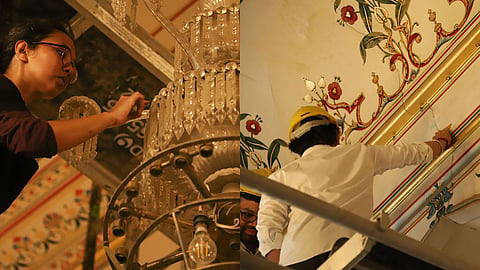
- HOMEGROWN WORLD
- #HGCREATORS
- #HGEXPLORE
- #HGVOICES
- #HGSHOP
- CAREERS
- ABOUT US
- CONTACT US

When Maharaja Sawai Jai Singh II founded Jaipur in 1727, he envisioned his new capital as a city built on cosmic harmony, scientific precision, and Rajput grandeur. Drawing on ancient Indian architectural and design treatises, the urban plan for Jaipur was laid out on a precise grid pattern by Vidyadhar Bhattacharya, a Bengali scholar and architect who planned the city according to the principles of Vastu Shastra and Shilpa Shastra. At its centre stood the City Palace — a sprawling complex that served as both royal residence and administrative centre for Jaipur's Kachhwaha dynasty. Sabha Niwas, or the Hall of Public Audience — once the stage for durbars and diplomatic ceremonies — was the beating heart of the Kachhwaha kingdom.
On 18 May, International Museum Day 2025, the Maharaja Sawai Man Singh II Museum Trust reopened this richly symbolic space to the public after a major conservation effort that restored not just the historic durbar hall's architecture, but the courtly spirit and artisanal legacy it once embodied. Transformed into an immersive exhibition space that narrates the political and symbolic life of the Jaipur court, the Sabha Niwas now presents a curatorial reimagining of courtly ritual, drawing inspiration from Pratap Prakasha, a rare 18th-century manuscript detailing an idealised day in the life of Maharaja Sawai Pratap Singh (1764-1803).
The conservation process, which began in July 2024, focused on more than architectural preservation. It sought to honour the living knowledge systems embedded in the building itself and revive the original architectural language of the hall — from its open marble arches to the gold-detailed ceilings — while re-affirming its role as a place of assembly, arts and craft heritage, and collective memory. Crucially, the project placed local artisans at its centre. Techniques such as gold leaf work, natural pigment fresco painting, araish lime plaster, and intricate stone carving were executed by traditional artisans, many of whom inherited these skills over generations.
This emphasis on indigenous knowledge challenges the prevailing trend of commercial conservation and underscores the living nature of Rajasthan's craft heritage. The exhibition's centrepieces include ceremonial 19th-century howdahs, including one that once carried Queen Elizabeth II during her 1961 visit; late 19th-century European-style thrones; a grand canopy unveiled for the first time in over six decades; and larger-than-life portraits by court painter Sahibram which were originally commissioned for the Sabha Niwas. These rare artefacts represent a court culture in dialogue with both local traditions and global currents.
Historically, the Sabha Niwas was a space of immense political and cultural significance to the Kachhwahas, who trace their lineage back to the 12th century and ruled the region of Amber and later Jaipur, navigating shifting political landscapes from Mughal alliances to British suzerainty. It served as the principal venue where the Kachhwaha kings of Jaipur held court, welcomed visiting dignitaries, and conducted matters of state. As part of its adaptive reuse, it now presents an exhibition that offers a window into the rituals, proceedings, and symbolism of Jaipur's royal court.
“The Sabha Niwas holds immense meaning for me (...) During the conservation process, the goal was never to freeze it in time, but to restore it in a way that allows it to continue serving its role, as a place of assembly, ceremony, and conversation.”
Maharaja Sawai Padmanabh Singh of Jaipur
That role — as a site of assembly, cultural memory, and conversation — now enters a new chapter. In reopening the Sabha Niwas as a public museum and exhibition space, the Maharaja Sawai Man Singh II Museum Trust has not only restored this living monument, but reasserted the purpose of cultural spaces as forums for dialogue, ceremony, and continuity.
The Sabha Niwas, located in The City Palace, Jaipur, is open to visitors from 9:30 am to 6:30 pm every day. You can purchase e-tickets to visit the City Palace here.
If you enjoyed reading this, here's more from Homegrown:
A Homegrown Guide To Colonial-Era, Indian-Inspired Architecture In The United Kingdom
Athangudi Tiles Are A Uniquely Chettinad Amalgamation Of Colour, Technique, & Culture
Cowies: A Slice of Mumbai’s Past Has Been Turned Into A Modern Traveller's Retreat
